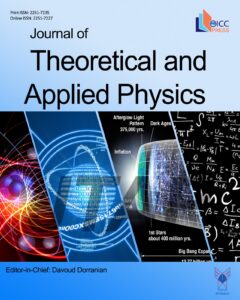Evolution of shapes in even–even nuclei using the standard interacting boson model
Authors
Abstract
AbstractThe sd-version of the interacting boson model (IBM) is used to establish the shape phase transitional structure. A simplified Hamiltonian is used which is intermediate between the three dynamical symmetries of U(6), namely the spherical U(5), the prolate and oblate deformed SU(3) and the γdocumentclass[12pt]{minimal} usepackage{amsmath} usepackage{wasysym} usepackage{amsfonts} usepackage{amssymb} usepackage{amsbsy} usepackage{mathrsfs} usepackage{upgreek} setlength{oddsidemargin}{-69pt} egin{document}$$gamma $$end{document}-unstable O(6) limits. The potential energy surfaces (PESs) to the IBM Hamiltonian have been obtained using the intrinsic state formalism which introduces the shape variables βdocumentclass[12pt]{minimal} usepackage{amsmath} usepackage{wasysym} usepackage{amsfonts} usepackage{amssymb} usepackage{amsbsy} usepackage{mathrsfs} usepackage{upgreek} setlength{oddsidemargin}{-69pt} egin{document}$$ eta $$end{document} and γdocumentclass[12pt]{minimal} usepackage{amsmath} usepackage{wasysym} usepackage{amsfonts} usepackage{amssymb} usepackage{amsbsy} usepackage{mathrsfs} usepackage{upgreek} setlength{oddsidemargin}{-69pt} egin{document}$$gamma $$end{document}. The Gadolinium (Gd) and Ruthenium (Ru) isotopic chains have been taken as examples in illustrating the U(5)–SU(3) and U(5)–O(6) shape phase transitions, respectively. We used the standard χ2documentclass[12pt]{minimal} usepackage{amsmath} usepackage{wasysym} usepackage{amsfonts} usepackage{amssymb} usepackage{amsbsy} usepackage{mathrsfs} usepackage{upgreek} setlength{oddsidemargin}{-69pt} egin{document}$$chi ^2$$end{document} test to get the IBM Hamiltonian parameters. The fit is performed by minimizing the χ2documentclass[12pt]{minimal} usepackage{amsmath} usepackage{wasysym} usepackage{amsfonts} usepackage{amssymb} usepackage{amsbsy} usepackage{mathrsfs} usepackage{upgreek} setlength{oddsidemargin}{-69pt} egin{document}$$chi ^2$$end{document} function for some selected experimental low-lying energy levels, the two neutron separation energies and B(E2) transition rates.



